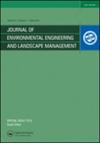ANALYSIS OF THE RADON CONCENTRATIONS IN NATURAL MINERAL AND TAP WATER USING LUCAS CELLS TECHNIQUE
IF 1.1
4区 环境科学与生态学
Q4 ENVIRONMENTAL SCIENCES
Journal of Environmental Engineering and Landscape Management
Pub Date : 2022-09-27
DOI:10.3846/jeelm.2022.17411
引用次数: 1
Abstract
The aims of this study were to determine the radon concentration in natural mineral and tap water and to estimate the resulting ingestion doses received by adults. Physical-chemical characteristics of water samples have also been investigated. In the last years have been an increase of water consumption of both, natural mineral and tap, many sources and producers being available on the market. Thus, the physical-chemical and radiologic parameters of water must be in compliance with the Drinking Water Directive (DWD). Thus, the study presents an assessment of the radioactivity due to 222Rn and 3H in several mineral natural water samples from the north region of Romania, but also in several tap water samples. The methods used were based on gamma spectrometry, gross alpha-beta measurements and beta spectroscopy, but also ICP-MS for chemical parameters. The results of this work showed that the geology and rock types clearly influence the water radon concentration. The radon concentration is lower in the water that passes through sedimentary rocks than that passing through granitic rocks. An important aspect of this work is to provide reliable information regarding radon and tritium concentrations. Radon concentration varied between 0.15±0.05 Bq/L and 11.35±2.97 Bq/L in the natural mineral water samples and between 0.17±0.05 Bq/L and 8.51±2.34 Bq/L in the tap water samples. An estimation of annual effective radiation dose based on the sample results was also made. Calculated values for ingestion dose due to regular consumption of water does not induce a health risk because of the intake of various radionuclides contained in the water. The maximum values being of 47.38 µSv/y. The determined values for the collected samples are below recommended reference levels, but more important aspect is that this study emphasise environmental sustainability in the investigated area.利用LUCAS细胞技术分析天然矿物和自来水中的氡浓度
这项研究的目的是确定天然矿物和自来水中的氡浓度,并估计成年人由此摄入的剂量。还对水样的物理化学特性进行了研究。在过去的几年里,天然矿物和自来水的消耗量都在增加,市场上有许多水源和生产商。因此,水的物理化学和放射学参数必须符合饮用水指令(DWD)。因此,该研究对罗马尼亚北部地区的几个矿物天然水样本以及几个自来水样本中222Rn和3H的放射性进行了评估。所使用的方法基于伽马光谱法、总α-β测量法和β光谱法,但也基于化学参数的ICP-MS。研究结果表明,地质和岩石类型对水氡浓度有明显的影响。穿过沉积岩的水中的氡浓度低于穿过花岗岩的水中的氡气浓度。这项工作的一个重要方面是提供关于氡和氚浓度的可靠信息。天然矿泉水中氡浓度在0.15±0.05 Bq/L和11.35±2.97 Bq/L之间变化,自来水样品中氡浓度在0.17±0.05 Bq/L和8.51±2.34 Bq/L之间变化。还根据样本结果估算了年有效辐射剂量。由于摄入了水中所含的各种放射性核素,由于经常用水而产生的摄入剂量计算值不会引起健康风险。最大值为47.38µSv/y。所收集样本的测定值低于建议的参考水平,但更重要的是,本研究强调了调查区域的环境可持续性。
本文章由计算机程序翻译,如有差异,请以英文原文为准。
求助全文
约1分钟内获得全文
求助全文
来源期刊
CiteScore
1.90
自引率
7.70%
发文量
41
审稿时长
>12 weeks
期刊介绍:
The Journal of Environmental Engineering and Landscape Management publishes original research about the environment with emphasis on sustainability.

 求助内容:
求助内容: 应助结果提醒方式:
应助结果提醒方式:


